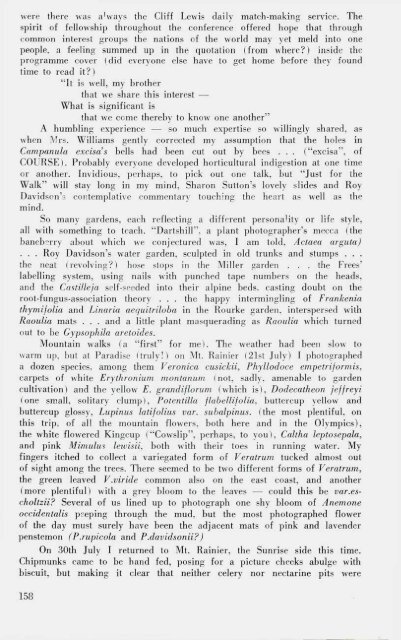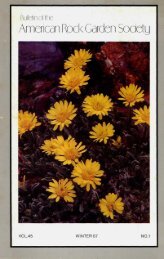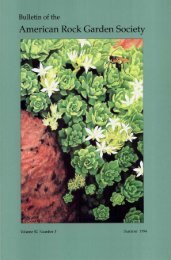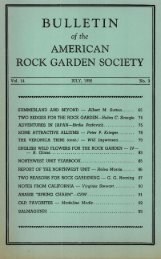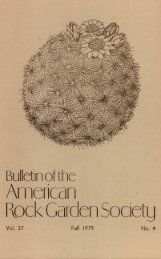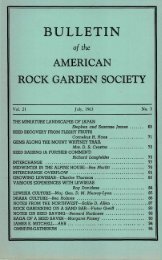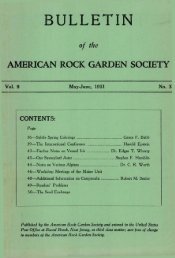Bulletin - Fall 1976 - North American Rock Garden Society
Bulletin - Fall 1976 - North American Rock Garden Society
Bulletin - Fall 1976 - North American Rock Garden Society
Create successful ePaper yourself
Turn your PDF publications into a flip-book with our unique Google optimized e-Paper software.
were there was always the Cliff Lewis daily match-making service. Thespirit of fellowship throughout the conference offered hope that throughcommon interest groups the nations of the world may yet meld into onepeople, a feeling summed up in the quotation (from where?) inside theprogramme cover (did everyone else have to get home before they foundtime to read it?)"It is well, my brotherthat we share this interest —What is significant isthat we come thereby to know one another"A humbling experience — so much expertise so willingly shared, aswhen Mrs. Williams gently corrected my assumption that the holes inCampanula excisa's bells had been cut out by bees . . . ("excisa", ofCOURSE). Probably everyone developed horticultural indigestion at one timeor another. Invidious, perhaps, to pick out one talk, but "Just for theWalk" will stay long in my mind, Sharon Sutton's lovely slides and RoyDavidson's contemplative commentary touching the heart as well as themind.So many gardens, each reflecting a different personality or life style,all with something to teach. "Dartshill", a plant photographer's mecca (thebaneberry about which we conjectured was, I am told, Actaea arguta). . . Roy Davidson's water garden, sculpted in old trunks and stumps . . .the neat (revolving?) hose stops in the Miller garden . . . the Frees'labelling system, using nails with punched tape numbers on the heads,and the Castilleja self-seeded into their alpine beds, casting doubt on theroot-fungus-association theory . . . the happy intermingling of Frankeniathymifolia and Linaria aequitriloba in the Rourke garden, interspersed withRaoulia mats . . . and a little plant masquerading as Raoulia which turnedout to be Gypsophila aretoides.Mountain walks (a "first" for me). The weather had been slow towarm up, but at Paradise (truly!) on Mt. Rainier (21st July) I photographeda dozen species, among them Veronica cusickii, Phyllodoce empetriformis,carpets of white Erythronium montanum (not, sadly, amenable to gardencultivation) and the yellow E. grandiflorum (which is), Dodecatheon jeffreyi(one small, solitary clump), Potentilla flabellifolia, buttercup yellow andbuttercup glossy, Lupinus latifolius var. subalpinus. (the most plentiful, onthis trip, of all the mountain flowers, both here and in the Olympics),the white flowered Kingcup ("Cowslip", perhaps, to you), Caltha leptosepala,and pink Mimulus lewisii, both with their toes in running water. Myfingers itched to collect a variegated form of Veratrum tucked almost outof sight among the trees. There seemed to be two different forms of Veratrum,the green leaved V.viride common also on the east coast, and another(more plentiful) with a grey bloom to the leaves — could this be var.escholtzii?Several of us lined up to photograph one shy bloom of Anemoneoccidentalis peeping through the mud, but the most photographed flowerof the day must surely have been the adjacent mats of pink and lavenderpenstemon (P.rupicola and P.davidsonii?)On 30th July I returned to Mt. Rainier, the Sunrise side this time.Chipmunks came to be hand fed, posing for a picture cheeks abulge withbiscuit, but making it clear that neither celery nor nectarine pits were158


